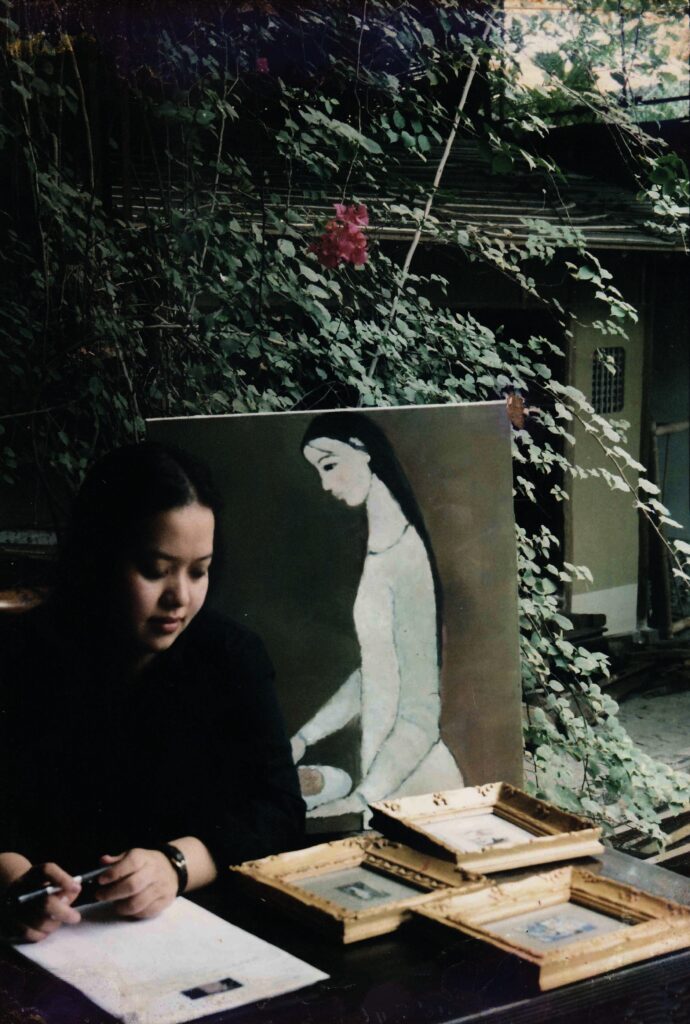Small and Miniature Masterpieces: The Art of Vietnam's Iconic Artists
Minh Chau Art Gallery's Exhibition

AN EXHIBITION OF SMALL-SCALE MASTERPIECES
TRIỂN LÃM NHỮNG BỨC TRANH NHỎ CỦA CÁC HỌA SĨ BẬC THẦY
It is likely that those who want to deal with any genre or aspect of Vietnamese modern painting cannot avoid reverting to its origin, namely Western art from which our artists have been benefiting since the beginning of the 20th century to date.
Small paintings or miniatures dated back to the Middle Ages in France. By the 10th-11th centuries, artists of that time had used the technique of small paintings to portray the life of Jesus Christ or illustrate the Holy Bible for religious preaching. Because of printing difficulties, the pictures had to be minimized with tiny details so as to fully express the essence of each work of art.
Có lẽ, muốn bàn về bất cứ một ngành nào, một khía cạnh nào của mỹ thuật cận đại Việt Nam, người tìm hiểu không thể nào tránh được việc quay về với nguồn gốc của hội hoạ Tây phương mà chúng ta đã được tiếp cập từ đầu thế kỷ XX đến nay.
Loại tranh khổ nhỏ hay còn gọi là tiểu hoạ có từ thời Trung Cổ ở Pháp. Khoảng thế kỷ X, XI các hoạ sĩ thời đó đã dùng kỹ thuật tiểu hoạ để miêu tả cuộc đời chúa Jesus và minh hoạ Thánh Kinh dùng cho việc truyền đạo. Vì hoàn cảnh in ấn thô sơ các tranh phải dùng khổ nhỏ, và do đó đi vào chi tiết để diễn tả tinh thần của mỗi tác phẩm.
In the 18th-19th centuries, especially when the impressionistic School reached its zenith, miniatures had on many occasions left their primary role as sketches to develop into a very original art school since the emotive fever of this genre sometimes towered over that of large-size paintings. Hence, artists had to spend more time meticulously refining miniatures until their total complete satisfaction. Yet this goal generally proves to be very difficult to attain, since the more the latter is finished and refined, the more they lose warm feelings and the freshness and vigour of the artist's strokes and colours an advantage commonly found in the initial drafts of sketches.
Cho tới thế kỷ XVIII, XIX, nhất là vào giai đoạn cực thịnh của trường phái Ấn Tượng, các bức tranh tiểu hoạ nhiều khi đã rời bỏ vai trò phác hoạ, ký hoạ của mình để trở thành một trường phái hội hoạ rất độc đáo mà sức mạnh truyền cảm trong nghệ thuật nhiều khi còn mạnh hơn cả tranh lớn mà các hoạ sĩ thường phải dành nhiều thời gian để sửa sang, tỉa tót cho đến khi hoàn thành vừa ý. Cái độ "vừa ý" đó thường khó đạt được, vì càng sửa sang, tỉa tót, tác phẩm càng mất đi những tình cảm nóng sốt, sự tươi mạnh của nét bút và màu sắc, thường thấy trong những bản phác thảo hay ký hoạ ban đầu.
To compare miniatures with large-size paintings, a genre that requires a great deal of time for their execution, Auguste Renoir, a French master painter, said: "To confront the two genres of paintings, I would like to make a comparison: Just like a passionate lovemaking during a short night with so many years of an ardent love." At this, Renoir's friends exclaimed "OH!" and they realized the value of the miniatures that Renoir left to the world.
Many great French impressionists like Monet painted miniatures and even street artist Utrillo left us plenty of small paintings.
Để so sánh hai loại tranh tiểu hoạ và các tác phẩm lớn phải mất nhiều thời gian thực hiện, một bậc thầy của hoạ sĩ Pháp, ông Auguste Renoir có nói: "Để so sánh hai loại tác phẩm này tôi muốn dùng một cuộc tình nồng nhiệt trong một đêm ngắn ngủi để so sánh với một cuộc đời ân ái nhiều năm". Các bạn của Renoir đã "ồ" lên một tiếng và hiểu rõ sức mạnh của những bức tiểu hoạ mà Renoir còn để lại cho thế giới.
Rất nhiều hoạ sĩ Pháp thuộc trường phái Ấn tượng như Monet cũng vẽ loại tiểu hoạ này. Ngay cả hoạ sĩ đường phố Utrillo cũng để lại rất nhiều tác phẩm nhỏ.
A single Renoir's or Monet's miniature was sold at Drouot auctions (Paris) for USD 40,000 - USD 50,000 and it measured only 15 × 40 cm.
Một bức tiểu hoạ của Renoir hay Monet qua những cuộc bán đấu giá của Drouot (Paris) vẫn được bán với giá từ 40,000 đến 50,000 USD cho một bức khổ 15 x 40 cm.
Now, let's return to our Vietnamese art. In reality, few of our ant collectors pay special attention to this genre of painting. Legend tells us that in Bui Xuan Phai's lifetime, his friends used to come to see him. They lingered at his home to watch him paint and talk. The master painter told them about the power and great success of miniature paintings. He said: "Don't look down upon miniatures, they are very beautiful and by no means inferior to the large-size paintings which artists have spent lots of time to execute and embellish."
Bây giờ, hãy trở lại chuyện của hội hoạ nước ta. Thật ra tại Việt Nam đang ít khách sưu tầm tranh đặc biệt chú ý đến loại tranh nhỏ này. Được biết, trước đây bạn bè Bác Phái thường hay đến nhà Bác để la cà xem Bác vẽ và nói chuyện đều đã được nghe Bác Phái nói đến loại tranh nhỏ, sức mạnh và điểm thành công của nó, Bác thường nói: "đừng xem thường loại tranh nhỏ, nó rất đẹp, đẹp không kém gì tác phẩm cỡ lớn đã dùng nhiều thời gian hơn để tô điểm, thực hiện."
To turn his words into deeds, Bui Xuan Phai drew a series of miniatures with a steel pen dipped in red ink or pupil's blue ink. Most of the portraits are those of his friends or talented writers and artists in northern Vietnam and were done on pieces of paper as large as a matchbox. Later, a certain family acquired them and resold them on the market. When viewing them, art lovers could not help exclaiming their admiration before such wonderful and successful portraits. One more detail: Bui Xuan Phai did not fail to sign his name and at times, he even dated the miniature portraits. This is clear enough to show his regard and responsibility for each of his mini artworks.
Nói là làm, những bức tranh nhỏ vẽ bằng ngòi bút sắt chấm vào mực đỏ, mực xanh học trò, Bác Phái thực hiện hầu hết tất cả chân dung những người bạn, những người văn nghệ sĩ tài hoa đất Bắc trên những mẩu giấc nhỏ bằng hộp diêm mà một gia đình nào đó đã bán ra thị trường, và người yêu tranh đã không khỏi "ồ" lên thán phục khi đang đứng trước một chân dung cực kỳ đẹp và thành công. Hơn nữa, Bác Phái còn không quên ký tên, có khi đề cả năm, tháng... thì cũng đủ nói lên sự trân trọng, trách nhiệm đối với từng tác phẩm như thế nào.
The master painter quietly resolved his creative curiosity with this genre of miniature paintings. He made them while sitting or standing, at every hour or minute of his life. Upon completion, he signed them and dedicated them to a friend who he'd painted. Sometimes he threw them into the wastebasket as soon as he had finished them, fetched another piece of paper and went on drawing. Perhaps this genre of painting had responded to his creative artistic need. "Truyen Kieu" ("Kim Van Kieu") and Ho Xuan Huong's poems offered abundant inspiration to him, e.g. theses: "Men are hesitating: they are reluctant to go: - It's not good to miss the opportunity, but lingering is indecent behaviour!"
Bác Bùi Xuân Phái hầu như đã thầm lặng giải quyết băn khoăn sáng tạo của mình trong các tranh nhỏ, mà Bác đã vẽ khi ngồi, khi đứng, trong bất cứ một giờ phút nào của cuộc đời. Những bức tranh tí xíu ấy thường khi bác vừa vẽ xong, đã ký tặng ngay cho người bạn ngồi trước mặt. Có khi vừa vẽ xong, lại ném vào sọt rác rồi kiếm mẩu giấc khác để vẽ tiếp. Hình như loại tiểu hoạ đã thoả mãn được sự cần dùng sáng tác, Bác vẽ rất nhiều cảm xúc với truyện Kiều, và vẽ rất nhiều với thơ của Hồ Xuân Hương: "Quân tử dùng dằng đi chẳng dứt, đi thì cũng dỡ, ở không xong"...
The miniature paintings, including drafts or sketches by other contemporary artists on display at my exhibition today, are made by: Nguyen Phan Chanh, Tran Van Can, Dung Bich Lien, Nguyen Tu Nghiem, Nguyen Sang, Bui Xuan Phai, Nguyen Tien Chung, Luu Cong Nhan from North Vietnam and Nguyen Trung from South Vietnam. I think that they are sufficient to show the power and success of Vietnamese art, which follows the tradition of Western painting: "Any genre of painting will do. It is essential that one should add something that has never been found in the world's art."
Những tác phẩm nhỏ, những phóng tác hay ký hoạ của các hoạ sĩ hiện đại khác mà Phòng Trưng Bày Nghệ Thuật Minh Châu đang trình bày trong triển lãm hôm nay như: Nguyễn Phan Chánh, Trần Văn Cẩn, Dương Bích Liên, Nguyễn Tư Nghiêm, Nguyễn Sáng, Bùi Xuân Phái, Nguyễn Tiến Chung, Lưu Công Nhân ở miền Bắc và của Nguyễn Trung ở miền Nam, dường như cũng đủ để diễn tả sức mạnh và thành công của hội hoạ Việt Nam trong truyền thống của hội hoạ phương Tây: "Vẽ gì cũng được, cốt yếu là phải đem lại một cái gì mới chưa từng thấy trong hội hoạ đã có của thế giới."
An art critic from New Zealand wrote: "From the beginning of the 20th century up till now, the world's atmosphere of artistic creation has seemed to come to a dead end". Conversely, Vietnamese painting though still timid and awkward when it proceeds to do creative work and voice its opinion or notwithstanding it is only a "distant relative" of European Impressionism and Fauvism is still regarded as a fresh breeze of creativity. Vietnamese pictures are indeed contributing their presence to European museums and Western families. Now they are expanding to America…
Có một nhà phê bình nghệ thuật người Tân Tây Lan (New Zealand) đã viết: "Từ đầu thế kỷ XX cho tới nay, không khí sáng tạo nghệ thuật của thế giới hầu như bế tắc..." Hội hoạ Việt Nam tuy mới chập chững bước vào sáng tác và phát biểu ý kiến của mình, tuy nó là đứa "cháu xa" của trường phái Ấn Tượng, Dã Thú của châu Âu nhưng vẫn được xem như một luồng gió mát mẻ của sáng tạo, những bức tranh Việt Nam đang góp mặt trong các bảo tàng, nội thất của những gia đình châu Âu và giờ đây đang tiến vào Mỹ quốc.
In my opinion, the fact that Vietnamese art is present all over the world is due to a very simple reason: dissimilar to any other painting, it is very original and truly Vietnamese.
© Boi Tran Garden
Minh Châu thiết nghĩ, sự thật, hội hoạ Việt Nam có mặt khắp nơi trên thế giới vì một lý do rất giản dị: không giống ai, độc đáo và rất Việt Nam.
© Nhà Vườn Bội Trân

